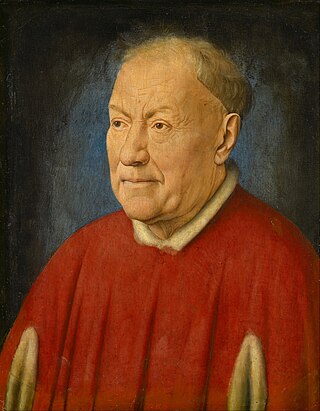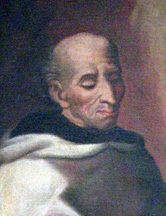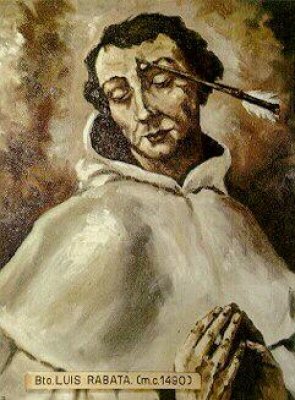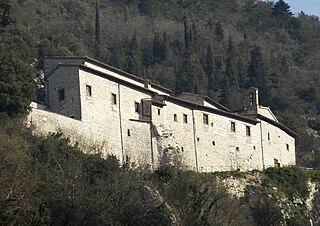
Szymon of Lipnica was a Polish catholic priest and a professed member from the Order of Friars Minor. He became a sought after and noted preacher and took as his preaching inspiration Saint Bernardine of Siena and also was a strong proponent of popular devotions that he worked to spread.

Niccolò Albergati was an Italian Carthusian and a prelate of the Roman Catholic Church. He was appointed cardinal and served as a papal diplomat to France and England (1422–23) in addition to serving as the bishop of Bologna from 1417 until his death.

Pacificus da Ceredano - born Pacificus Ramati - was an Italian Roman Catholic priest and a professed member from the Order of Friars Minor. Pope Benedict XIV approved his "cultus" and beatified him on 7 July 1745.

Angelo Paoli, O.Carm – born Francesco – was an Italian Catholic priest and a professed member from the Carmelites. Paoli became known as the "father of the poor" due to his strong charitable outreach, for which he received praise from a number of cardinals and other prelates while living in Rome. This extended to his friend Cardinal Giuseppe Maria Tomasi and to Popes Innocent XII and Clement XI, who both offered him the cardinalate, which he refused.

Stanisław Kazimierczyk was a Polish Catholic priest and a professed member of the Canons Regular of the Lateran. He became noted for his ardent devotions to both the Eucharist and to his personal patron saint, Stanislaus of Szczepanów, as well as for his charitable dedication to the ill and poor of Kraków.

Blessed Ladislas of Gielniów was a Polish Roman Catholic priest and a professed member of the Order of Friars Minor. He was an observant of the Rule of Saint Francis of Assisi and served his order in various capacities that included both a doorkeeper and as its provincial. He also travelled across Poland to evangelize to the faithful and was a noted preacher.

Andrea Franchi was an Italian Roman Catholic member of the Order of Preachers who served as the Bishop of Pistoia before his resignation due to ill health. Franchi became a noted preacher and evangelist who was also known for his holiness and his deep commitment to the poor of his diocese.

Luigi Rabatà, O.Carm was an Italian Roman Catholic priest from the Order of Carmelites. He served as prior of his convent of Randazzo until his death which occurred after an attack in which an arrow was shot into his head.

Domenico Spadafora was an Italian Roman Catholic priest and a professed member of the Order of Preachers. Spadafora was a noted evangelist and attracted countless to the Dominican fold while also converting the hearts of others who led dissolute lives. He is best known for being the first superior of a church he oversaw construction of in Monte Cerignone after receiving the papal approval of Pope Alexander VI to commence such work.

Ugolino da Gualdo Cattaneo was an Italian Roman Catholic professed religious and friar of the Order of Saint Augustine. Ugolino is best known for founding an Augustinian convent in Gualdo Cattaneo in 1258 where he served as its prior until his death. He practiced a rigorous spiritual life with austerities including frequent bouts of strict silence and fasting.

Elena Duglioli was an Italian Roman Catholic aristocrat from Bologna noted for her devotion to Christian life and social teachings. Duglioli wanted to become a nun for the Poor Clares but instead married in order to please her parents. Duglioli is best known for commissioning a chapel with an image of Saint Cecilia to whom she was devoted.

Antonio Patrizi was an Italian Roman Catholic priest and a professed member of the Order of Saint Augustine. Patrizi joined the order in Lecceto and lived as a hermit prior to his sudden death while visiting his friend at another convent.
Rinaldo da Concorezzo was an Italian Roman Catholic priest and archbishop who served as the Bishop of Vicenza from 1296 until his 1303 appointment as the Archbishop of Ravenna-Cervia holding that until his death.

Guala de Roniis was an Italian catholic priest and a professed member of the Order of Preachers as one of Dominic of Osma's earliest disciples. De Roniis was born as a noble and was appointed as the Bishop of Brescia after Dominic's death though also served as a popular papal legate that earned him popular and papal support. He resigned from his episcopal see to dedicate the remainder of his life to peaceful solitude though his reputation for personal holiness prompted countless people to seek him out for his counsel.

Blessed Marco da Montegallo was an Italian Roman Catholic priest from the Order of Friars Minor. He was born to a nobleman and served as a doctor in Ascoli Piceno before he was pressured into marriage in 1451 - the couple annulled their marriage after both entered the religious life. Father Marco is best known for establishing pawnshops for the poor across various Italian cities and for being a preacher of love.

Giacomo Bianconi was an Italian Roman Catholic priest and a professed member of the Order of Preachers. Bianconi - who hailed from Umbria - joined the order in his adolescence and dedicated his pastoral career to his flock and on one notable occasion aided refugees when Frederick II sacked the area in 1248. He also combatted heresies and managed to convert one of their chief propagators while also distinguishing himself through his life of extreme poorness that went past the Dominican standards.
Giovanni de Surdis Cacciafronte was an Italian Roman Catholic priest and bishop from the Order of Saint Benedict. He served as the Bishop of Mantua from 1174 until his resignation in 1177 and held the position of Bishop of Vicenza from 1179 until his murder. The schism that Antipope Victor IV caused enabled him to proclaim his support for Pope Alexander III though leading to his removal from a position at the behest of Frederick Barbarossa.
Blessed Hartmann of Brixen was a German prelate of the Catholic Church, who served as the Bishop of Brixen from his appointment in 1140 until his death. Hartmann served alongside the Order of Saint Augustine - who oversaw his education - and he managed certain aspects of their order despite not being part of that congregation. He also supported Pope Alexander III during his struggle with Frederick Barbarossa and also earned the favor of the latter despite Hartmann's views of the schism.
Bonaventura Tornielli was an Italian Roman Catholic priest and a professed friar from the Servite Order. Tornielli was born into a noble household and was a noted preacher in which he visited numerous Italian cities such as Florence and Perugia - Pope Sixtus IV held him in high esteem and even named him the "Apostolic Preacher". He also held various positions of leadership within his order.

The Monastero or Eremo di Sant'Ambrogio is a 14th-century Roman Catholic church and monastery located on Via Guido Bonarelli #5 nestled on high slopes of Monte Foce, north of Gubbio, region of Umbria, in Italy. It was initially founded as a rustic Franciscan hermitage following Augustinian rules, outside the city walls of Gubbio.
















